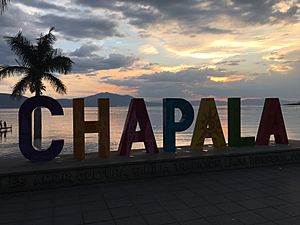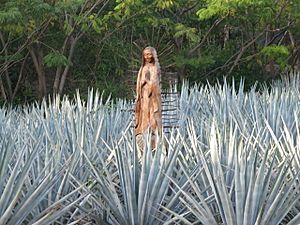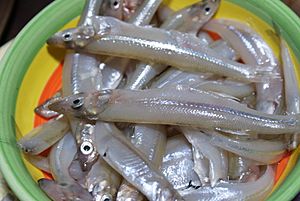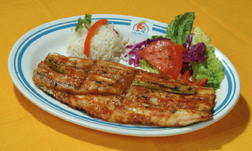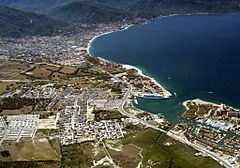Jalisco facts for kids
Quick facts for kids
Jalisco
Estado Libre y Soberano de Jalisco
|
|||
|---|---|---|---|
| Free and Sovereign State of Jalisco | |||
|
|||
| Motto(s):
Jalisco es México
(English: "Jalisco is Mexico") |
|||
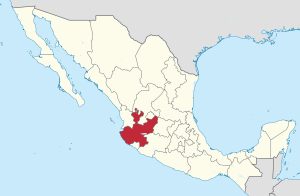
Jalisco within Mexico
|
|||
| Country | Mexico | ||
| Capital | Guadalajara | ||
| Largest city | Guadalajara | ||
| Municipalities | 125 | ||
| Admission | December 23, 1823 | ||
| Order | 9th | ||
Jalisco is one of the states in Mexico. Its capital city is Guadalajara. Jalisco is a very important state in Mexico. It has many natural resources and a rich history. Many things that people think of as "Mexican culture" actually started in Jalisco. These include mariachi music, ranchera music, and even tequila!
Jalisco is one of the top three states in Mexico for its economy. Many industries are found around Guadalajara, which is the second-largest city area in Mexico. Two main groups of native people live here: the Huichols and the Nahuas. Many people from the United States and Canada also live in Jalisco, especially around Lake Chapala and Puerto Vallarta.
The state of Jalisco is divided into 126 smaller areas called municipalities. Each municipality has a leader called a municipal president, like a mayor. In 2016, about 7.8 million people lived in Jalisco.
Contents
History of Jalisco
People first arrived in the Jalisco area about 15,000 years ago. These early people were nomads, meaning they moved from place to place. Some of the oldest signs of humans are found near the old Zacoalco and Chapala lakes. Scientists have found human and animal bones there. They also found tools made from bone and stone.
Other signs of early people include petroglyphs (rock carvings) and cave paintings. These can be seen in different parts of the state. About 7,000 years ago, people in this region started farming. This led to the first permanent villages in western Mexico. Over time, many different groups of people have lived in the Jalisco area.
Geography and Natural Environment
Jalisco is a large state, covering about 78,599 square kilometers (30,347 square miles). It is the seventh-largest state in Mexico. Jalisco is located on the central western coast of the country. It has 342 kilometers (213 miles) of coastline along the Pacific Ocean.
The land in Jalisco is very diverse. You can find forests, beautiful beaches, flat plains, and large lakes. Jalisco is special because it has all five of Mexico's natural ecosystems. These include dry scrub-lands, tropical forests, grasslands, and temperate forests with oak and pine trees.
Jalisco is home to many different kinds of animals and plants. More than half of all bird species in Mexico live here. That's about 525 different types of birds! Also, 40% of Mexico's mammals and 18% of its reptile species are found in Jalisco. There are also 7,500 different kinds of plants. This amazing variety is because Jalisco is located between the cooler north and the tropical south. It also sits near the Sierra Madre del Sur mountains and the Trans-Mexican Volcanic Belt. These features create many different natural conditions.
Lake Chapala is located in Jalisco. It is the biggest and most important freshwater lake in Mexico. It makes up about half of all the lake surface in the country.
Tequila: A Special Drink from Jalisco
Tequila is a famous type of drink that comes from a small area in Jalisco. It is made mostly from the blue agave plant. Tequila is the most well-known type of mezcal from Mexico. It is made in factories following strict rules.
The tequila industry is very important to Jalisco. It helps about 200,000 people find jobs, either directly or indirectly. Long ago, before the Spanish arrived, people used the agave plant to make a special drink for ceremonies.
The first person to get official permission to make and sell this drink was José Antonio Cuervo in 1758. Tequila became even more popular when railroads were built. This made it easier to ship the drink to other places.
Tequila comes in different styles:
- Blanco: This is clear and not aged.
- Reposado: This is aged in oak barrels for two months to one year.
- Añejo: This is aged in oak barrels for one to three years.
- Extra Añejo: This is aged for at least three years.
The tequila industry is very important for Jalisco's economy. The area where tequila is made is also a popular place for tourists. More than 17 million visitors come each year.
Delicious Cuisine of Jalisco
Jalisco is famous for its delicious food! Some classic dishes include local versions of pozole, sopitos, menudo, guacamole, and birria. Birria is a meat stew made with roasted chili peppers and spices. It can be made with goat, mutton, or beef.
Another popular dish is tortas ahogadas. These are pork sandwiches on French rolls, covered in a special tomato and chili pepper sauce. You can also find many common street foods like sopes, tacos, and enchiladas.
Near Lake Chapala, a special dish called charales is popular. These are small fish. Guadalajara is especially known for its tortas ahogadas.
For sweets, you can try alfajor, squash seeds with honey, coconut candies, and buñuelos. Many fruits are also preserved in syrup. Popular drinks include tequila, aquamiel, pulque, and tejuino. Along the coast, people enjoy a drink called raicillia.
If you visit the coast, you'll find lots of seafood. Some popular seafood dishes include shrimp breaded with coconut. There's also rollo del mar, which is a fish fillet stuffed with shrimp and octopus. It's often wrapped in bacon and covered in a chili pepper or almond sauce.
Puerto Vallarta is a great place for food lovers. It hosts the Mexican Gastronomy Fair every November. Before it became a tourist spot, Puerto Vallarta was a fishing village. A simple grilled fish dish called pescado zarandeado is still very popular there.
Tourism and Fun in Jalisco
Jalisco is a popular place for tourists. The most famous resort is Puerto Vallarta. But the Pacific coast of Jalisco also has many other smaller beach resorts. These include Cuastecomates, La Manzanilla, Tenacatita, Boca de Iguanas, Playa Tecuán, and Barra de Navidad.
Most of Jalisco's tourism is focused on Puerto Vallarta and the city of Guadalajara. The state has the second-highest number of hotels and tour agencies in Mexico. It also has the third-highest number of hotel rooms. This means there are plenty of places to stay and things to do for visitors!
Images for kids
-
View of a sunny day near Mascota, Jalisco in January
-
Colorful painted egg shells, filled with confetti, handmade by village children and used to celebrate the most important traditions of Ajijic, Jalisco.
-
Typical Mariachi of Jalisco.
-
Parroquia de Santiago Apostol, in Tequila
-
Parroquia de Nuestra Señora de la Asuncion, en Lagos de Moreno
-
Parroquia de San Miguel Arcangel in San Miguel el Alto
-
Catedral Basílica de Nuestra Señora de San Juan de los Lagos in San Juan de los Lagos, 2nd most visited religious center in the country
-
Basilica of Our Lady of Zapopan, in Zapopan
-
Parroquia de Nuestra Señora de Guadalupe, in Puerto Vallarta
See also
 In Spanish: Jalisco para niños
In Spanish: Jalisco para niños





